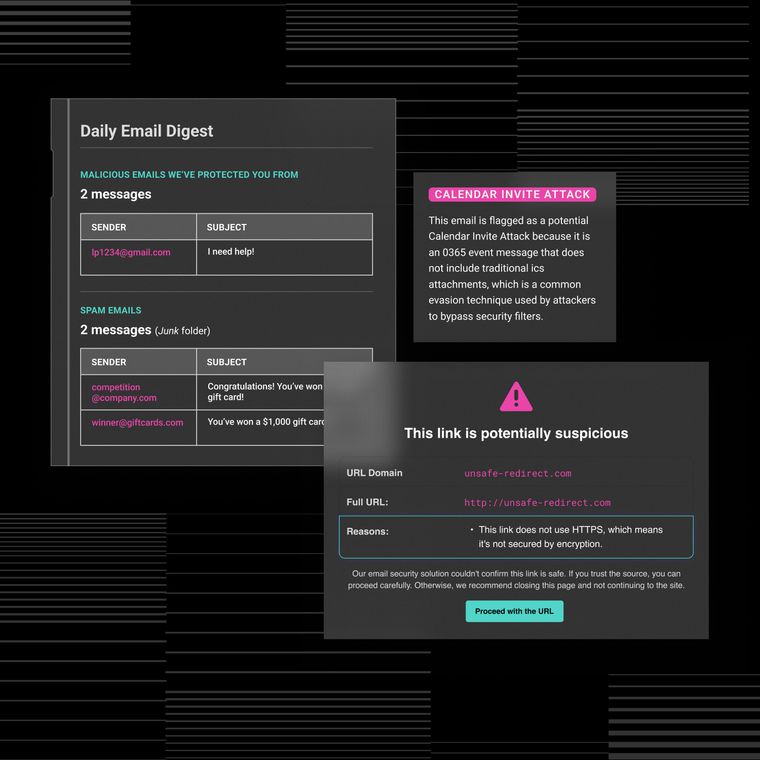Step by Step How to Guide to Cyber Awareness Training
Teach employees how to spot threats with this clear, actionable training framework for better cyber hygiene.
July 28, 2025
Human error contributes significantly to security breaches, as high as 74 percent, and each incident costs organizations an average of $4.88 million. The stakes are clear: when employees click a phishing link, expose personal information, or compromise an email address database, the financial and reputational damage can be devastating.
This framework transforms security awareness from checkbox training into behavioral change through five strategic steps. You will learn how to assess your current risk profile, develop engaging content, launch programs at scale, measure real impact, and build lasting security habits across your organization. The approach aligns with DoD Cyber Awareness Challenge principles while addressing modern threats like AI-generated phishing and business email compromise.
Step 1 – Assess Your Current State and Define Objectives
A precise baseline lets you target the riskiest behaviors and set measurable objectives that drive down human-driven incidents.
Create a Data-Driven Security Baseline
Start by gathering data, not opinions. Launch realistic phishing simulations to capture click-through and reporting rates across the workforce. Pair those results with anonymous security surveys that probe password habits, social-engineering awareness, and data-handling confidence. Conduct a policy audit to surface any disconnect between documented requirements and day-to-day practice.
Together, these inputs reveal exactly where employees struggle, which roles present outsized risk, and which compliance gaps could trigger fines. Capture every metric. The numbers will anchor your goals and prove progress later.
Data without direction stalls programs. Convert each risk into a SMART goal: Specific, Measurable, Achievable, Relevant, and Time-bound. If 28% of users clicked a phishing link, set a 12-month target to cut that rate to 10%. Tie every goal to board-level concerns such as financial exposure or regulatory penalties.
Mapping objectives to compliance standards keeps auditors satisfied and ensures budget support. Track progress monthly and adjust goals only when fresh baseline data justifies the change.
Use your baseline to rank the curriculum. Phishing and business email compromise typically lead, followed by password security, social engineering, and data protection. Capture the intent in a succinct objective statement: For example, you can state that "By Q4, reduce employee-initiated security incidents by 40% by delivering quarterly micro-trainings, monthly phishing simulations, and targeted remediation for repeat offenders, while maintaining 100% completion on mandated compliance modules."
This statement clarifies scope, metrics, timeline, and accountability. With a data-driven baseline and SMART objectives in hand, you're ready to select content that closes the exact gaps you've surfaced.
Step 2 – Develop and Select Effective Training Content
Choose training content that is timely, engaging, and role-specific so employees practice the exact behaviors that lower your organization's risk.
Relevant material mirrors the threat landscape. Attackers constantly refine phishing lures and social engineering tactics, so stale slides put you a step behind. Keep pace by reviewing content annually and adding quarterly updates that address new tactics highlighted in threat intel feeds. Source material efficiently with three complementary streams:
Third-party platforms that bundle videos, simulations, and analytics for rapid deployment
Custom micro-learning modules your team creates to reflect proprietary workflows or recent incidents
Free or low-cost government and nonprofit resources you can remix into branded lessons
The medium matters as much as the message. Employees retain more when they practice spotting phishing emails inside interactive simulations or walk through scenarios that show exactly how a compromised email address leads to wire-fraud losses. Storytelling, branching scenarios, and short knowledge checks break monotony and help you measure comprehension in real time.
Different roles need different depth. Finance teams must rehearse business-email-compromise attacks, while developers benefit from secure-coding refreshers. Platforms that use AI-driven personalization automatically push extra lessons to users who miss quiz questions, and Abnormal's AI Phishing Coach delivers just-in-time tips the moment someone hovers over a suspicious link.
Plan for freshness. Lock in a yearly overhaul of every module and schedule quarterly micro-updates for emerging threats such as QR-code phishing or generative-AI voice fraud. Skipping these iterations invites information decay.
Avoid predictable pitfalls: information overload that buries key takeaways, dated screenshots that erode credibility, and inaccessible formats that exclude part of the workforce. Each one undercuts engagement and wastes budget.
Training Content Evaluation Checklist
Use this evaluation checklist before releasing any module:
Does the topic map to a documented risk or compliance requirement?
Is the scenario no more than 12 months old?
Can employees finish in under eight minutes?
Does it include an immediate knowledge check and remediation path?
Have you verified accessibility (captions, screen-reader compatibility)?
Build every lesson against these guardrails and you will launch a training library that drives measurable behavior change instead of just logging completion statistics.
Step 3 – Choose Optimal Delivery Methods and Launch Training
Deliver training through multiple channels tailored to your workforce, then launch with leadership-backed communications that set the tone.
A single format never fits everyone. Smaller teams often succeed with a lightweight LMS that hosts short e-learning videos, while global enterprises blend LMS content with live workshops, virtual instructor-led sessions, and in-flow coaching.
Gamified modules raise engagement and retention levels for frontline staff—employees consistently rate these higher than slide decks. High-risk or highly regulated roles benefit from deeper, scenario-driven simulations delivered by adaptive platforms that personalize difficulty based on user behavior.
When selecting a delivery mix, weigh three variables: the size and distribution of your workforce, bandwidth limitations of remote sites, and the cultural appetite for interactive learning. If a significant portion of employees has limited connectivity, prioritize mobile-first micro-learning and asynchronous videos. If your culture thrives on collaboration, schedule live workshops that encourage peer discussion.
Any rollout rises or falls on communication. Start with visible executive support: a short, signed email from the CEO making it clear that cybersecurity is a business imperative. Follow a three-touch cadence—announcement email, messaging-platform reminder, and a quick mention at the next town hall—each framed around WIIFM ("What's in it for me") so employees understand how training protects their personal information and job efficiency.
Pre-Launch Preparation and Rollout Strategy
Before the first module reaches inboxes, run through a tight pre-launch checklist:
Configure LMS groups and completion deadlines
Pilot test content with a small, diverse cohort
Secure communication approvals from HR and legal
Stage phishing simulations to benchmark current risk
Large organizations avoid disruption by rolling training out in waves: begin with one division, refine based on feedback, and expand every two weeks. Anticipate resistance; busy employees skip non-mandatory tasks unless you make success visible.
Publish completion leaderboards, celebrate quick reporting of simulated phishing attacks, and offer small rewards like security-branded coffee cards. Momentum builds quickly once employees see that the program is practical, recognized, and reinforced from the top down.
Step 4 – Implement Regular Refreshers and Measure Effectiveness
Quarterly micro-trainings paired with real-time metrics keep your users sharp and give you defensible evidence that the program is driving down risk.
Start by locking in a cadence: a ten-minute refresher every quarter and one deep, role-based course each year. Regular touchpoints prevent the knowledge decay that plagues one-and-done programs.
Align each refresher with the latest threat intelligence to ensure optimal effectiveness. If ransomware gangs pivot to QR-code phishing, the next module tackles exactly that. Weekly threat briefs from security operations feed directly into the content so users see current adversary tradecraft rather than stale scenarios.
Automation keeps the schedule intact without drowning you in reminders. AI-driven platforms that group users by risk and send just-in-time nudges demonstrate up to 40% higher engagement.
Measuring Training Impact with Key Metrics
You need proof that these touchpoints work. Monitor four quantitative signals: completion percentage for each module, phishing simulation click rate and report rate with time-to-report, repeat-offender count, and human-driven incident frequency. Supplement the numbers with anonymous surveys and focus groups that uncover perception gaps.
Dashboards bring the story together. By merging LMS data, phishing results, and incident logs into a single view, you can brief executives in minutes and spot emerging weaknesses before attackers do.
Document everything. Regulators want evidence of both delivery and improvement, so it is best practice to archive curricula, attendance, quiz scores, and simulation results for several years (commonly three), although specific retention periods are typically set by organizational policy rather than explicit regulation.
Refresh, measure, refine, then repeat. That loop is how you turn awareness into measurable resilience.
Step 5 – Foster a Sustainable Security Culture
A security-first culture takes root when every employee can spot threats, report them instantly, and feel rewarded for doing the right thing. This cultural transformation shifts security from an IT department responsibility to a shared organizational value that influences daily decisions.
When employees understand both the "why" behind security practices and their personal role in protecting the organization, they become active defenders rather than compliance-driven participants.
Essential Practices for Building Security Culture
Streamline reporting. Add a one-click "Report Phish" button in email clients and document the follow-up workflow so staff know exactly what happens next. Simple reporting procedures keep response times low and promote transparency. Frequent reminders—in team chats, dashboards, and new-hire packets—reinforce the habit.
Recognize and reward good behavior. People repeat actions that earn positive feedback, and research shows interactive methods boost retention. Consider digital badges for first-time reporters of suspicious emails, quarterly prizes for the department with the lowest phishing-simulation click rate, and public shout-outs during all-hands meetings for employees who spot real attacks.
Gamify the experience. Leaderboards or team competitions turn training into a shared challenge and drive friendly rivalry, a proven way to increase engagement.
Embed security into daily rhythms. Make cyber awareness a mandatory line item in onboarding checklists, revisit it during annual performance reviews, and allocate five minutes in monthly town halls for a live threat update. Consistency signals that safe behavior is a core business expectation, not an optional add-on.
Share ownership beyond IT. Launch a security champion program that nominates one volunteer per department. Champions receive deeper training, act as first-line advisers, and feed frontline concerns back to the security team. This distributed model scales expertise and keeps messaging relevant to each business unit.
Vary content to avoid fatigue. Alternate micro-learning videos, newsletters, live workshops, and AI-driven platforms that adjust difficulty based on user performance. Quarterly refreshers aligned with the latest threat intelligence keep scenarios fresh and credibility high. By pairing easy reporting, positive reinforcement, and cross-functional advocates, you build a culture where secure behavior becomes the default.
Transform Security Awareness into Organizational Resilience
A disciplined five-step program transforms cyber awareness from compliance theater into measurable risk reduction. Baseline assessment, tailored content, strategic delivery, continuous measurement, and culture building create behavior change that directly impacts your security posture.
Begin with these immediate actions: conduct a baseline assessment to pinpoint your highest human-driven risks, establish SMART objectives that translate those risks into clear, time-bound targets, and plan your program launch by selecting delivery methods and communication tactics that fit your workforce.
To strengthen phishing defense and enable real-time coaching, explore Abnormal's platform. Start today. Every week of delay extends your exposure to preventable human error.
Related Posts
Get the Latest Email Security Insights
Subscribe to our newsletter to receive updates on the latest attacks and new trends in the email threat landscape.


